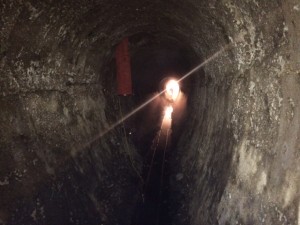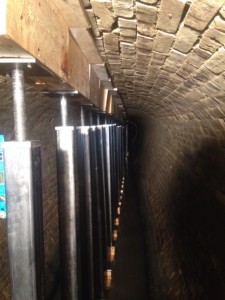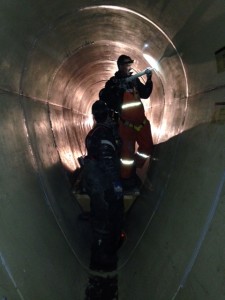Grouted in Place Panel Lining Rehabs Stormwater Relief Tunnels,Toronto, Ontario, Canada
Rehabbing a Pair of Egg-Shaped Sewers in Winnipeg ,Canada with Sliplining

Written by Andy Sherwin
When two egg-shaped sewers exhibited signs of advanced structural distress, city officials in Winnipeg, Manitoba, turned to trenchless rehabilitation methods for a solution.
Located in the geographic center of Canada, and home to more than 730,000 people, Winnipeg, like most cities of its size and age, has an extensive inventory of large diameter brick and monolithic concrete sewers installed by hand mining.

Sade Canada based out of Quebec City mobilized to Winnipeg to access both Trunk Sewers and complete pre-manufacturing surveys. This was completed manually, by taking measurements every 1m of the height and width of the sewer.
These sewers, in service since the late 1800’s, are typically located near the downstream end of large combined sewer districts. Failure or loss of service of these critical assets could result in extensive basement flooding, sewer overflows to the river and extremely costly repairs under emergency conditions.
AECOM Canada Ltd. has, for many years, worked with the City of Winnipeg to assess viable rehabilitation alternatives to extend the useful life of critical linear infrastructure. In 2014, AECOM was commissioned to design, tender and provide contract administration services for rehabilitation of two large diameter egg-shaped sewers – the Selkirk Avenue and Mission Street trunk sewers – both exhibiting signs of advanced structural distress.
RELATED: Grouted-in-Place Panel Lining: Rehabs Stormwater Relief Tunnels
Nearing Failure
The Selkirk Avenue trunk sewer is a 2,030-mm by 1,630-mm egg-shaped brick sewer conveying flows from the Selkirk Combined Sewer District. Originally, this sewer discharged directly to the Red River via a wood stave outfall. However, during construction of the City’s North End Water Pollution Control Centre, in the 1930’s, domestic (dry weather) sewage flows were diverted to the main interceptor and ultimately the treatment plant. The trunk sewer was originally constructed using open-face, hand mining techniques, as was typical for large diameter sewer construction in the City at the time.
The 135-m manhole-to-manhole section of the Selkirk Avenue trunk targeted for rehabilitation was exhibiting reverse curvature at the crown (hearting).
The Mission Street trunk sewer is a 2,980 mm by 1,980 mm monolithic concrete trunk sewer that is approximately 50 m length, conveying flows from the Mission Combined Sewer District. As with the Selkirk Avenue trunk, the sewer originally discharged directly into the Red River and has since had domestic (dry weather) sewage flows diverted to the City’s wastewater treatment plant.
RELATED: Outdoor Solutions Uses Satellite Technology to Pre-Survey HDD Route
Design and Tech
Preliminary design for the sewer rehabilitation project identified appropriate technologies and methodologies, reviewed pipe access requirements, and developed cost estimates for the work. During the preliminary design stage, rehabilitation with cured-in-place-pipe (CIPP), segmental sliplining with glass reinforced polymer (GRP) sections, and spiral wound PVC were assessed for applicability of the technology, deployment requirements, structural adequacy and installation risk.
Installation of any rehabilitation process involves a degree of risk. Both the Selkirk Avenue and Mission Street trunks posed their own unique construction challenges in the form of depth, complex horizontal geometry, navigation an existing weir chamber, and working within developed neighborhoods.
Depths of the sewers range from 7 to 8 m, and development of any access shafts were likely to be a complex undertaking. The Selkirk Avenue trunk also contained a horizontal curve near the upstream portion of the pipe run, with a radius of approximately 12 to 13 m. While the radius of the bend is relatively large, even minor deflections can create issues for contractors deploying rigid panels or flexible liners.
In addition to the geometric issues, the manhole structures and associated infrastructure at each site ranged in age from 80 to more than 100 years old. Thus, a contractor entering the sewers to complete the work has to contend with manholes and chambers that are in various states of disrepair.

The crown of the sewer, approximately 15m (50ft) from the downstream manhole, had settled/dropped approximately 70mm (3 in) requiring temporary bracing to be installed.
In order to avoid modifications to the existing weir chamber and manholes, recommended access shaft locations were identified for accessing the sewer and launching the rehabilitation products. For the Selkirk Avenue trunk, an access shaft immediately downstream of the horizontal curve was selected, allowing straight liner sections to be pulled in without the issues associated of navigating the curved sewer.
The hydraulic conditions of each sewer were assessed for both bypass pumping requirements and effects of the reduced cross section, resulting from the selected rehabilitation method. An assessment of each combined sewer district indicated peak dry weather flows of 145 L/s for the Mission Street trunk and 78 L/S for the Selkirk Avenue trunk. Bypass flows of these magnitudes add a degree of complexity and cost to the rehabilitation work but can be dealt with by careful planning, deployment of the correct equipment, and proper operating procedures.
Long-term hydraulics of each section were assessed and as with most rehabilitation projects the final product has a significantly reduced roughness factor and a correspondingly higher peak flow rating.
Trenchless Options
Spiral wound PVC liners have been present in the industry for some time and provide a fully structural liner when combined with both a competent host pipe and annulus grouting program. The PVC liners offer several advantages over CIPP and GRP operations as it can typically be deployed through existing manholes, are customizable to any size or shape of sewer and can be installed in live flow.

Workers inspect a completed section of the sewer.
However, the installation of spiral wound PVC liners requires the design and manufacture of a custom installation frame for each profile type, thus this type of liner is considerably more cost-effective for long or multiple installation lengths with the same cross section. Further, the liner itself has minimal inherent strength and relies on an integral fit with the grout to form a composite structure with the host pipe.
For the Selkirk Avenue application, the grout would need to develop considerable structure to address the reverse crown deficiency. The ASTM Standard for spiral wound PVC, F1741, provides little guidance for non-circular design applications where fully structural liners are required and the WRc Sewerage Rehabilitation Manual recommends its use for Type 2 lining applications only (an un-bonded liner for resisting hydrostatic stress alone). It was not considered further in predesign, but was not fully discounted if a viable design approach complete with accompanying quality assurance requirements could be put forward.
The second product reviewed was CIPP. The required size of these liners and wall thicknesses precluded the use of non-reinforced tubes and pushed the limit of glass and carbon fiber as a reinforcing material. Further, CIPP lining of the Mission trunk sewer would require significant pre-work to restore the lost invert prior to lining. Discussions with CIPP venders at the time of the preliminary design indicated minimal interest from the qualified parties to undertake a CIPP installation due to the liner sizes and relatively short lengths.
Segmental lining with GRP panels was reviewed and considered to be the preferred option for base bid purposes. GRP lining techniques are well established and are ideally suited to unique profiles like egg shaped sewers. GRP panels are custom built to the requirements of the project and can be designed as either a WRc Type 1 or Type 2 product.
Type 1 liners are designed to form a composite structure with the existing host pipe whereas Type 2 liners assume the GRP to be supporting all external loads without any composite action with the host pipe, similar to the structural behavior of a tight fit CIPP liner. The inherent stiffness of the GRP panels and reduced reliance on the grout as a structural component for structural performance sets GRP lining apart from other non-circular lining methodologies.
Construction
Following award of the project, the low bid contractor, Sade Canada, of Quebec City, Quebec, mobilized to Winnipeg to access both trunk sewers and manually complete pre-manufacturing surveys by taking measurements every 1 m of the height and width of the sewer.
A template or mandrel, fabricated to the dimensions and length of the proposed GRP panel, was then transported through both sewers to ensure that there were no pinch points that would impede the installation of the lining system.
Once confirmed the dimensions were forwarded to Channeline International, the chosen GRP Structural Lining System Supplier, for the execution of shop drawings, modelling of curve sections and production scheduling. A Type 1 lining system was designed in accordance with the WRc Sewerage Rehabilitation Manual and manufactured by Channeline International.
In January 2016, Sade Canada mobilized to site and commenced the excavation of the two access shafts, installation of traffic control works and site safety systems. Cleaning of the sewers was completed using high-pressure water jetting technologies. Sacrificial steel rails were then bolted to the invert of the sewers to facilitate the GRP panels being winched into place, a very simple but effective and productive installation method.
On Jan. 22, the contractor performed a pre-lining CCTV inspection, immediately prior to the insertion of the initial GRP panels. Three days later, the contractor attempted to install the first liner on Selkirk Avenue, only to find that the crown of the sewer – approximately 15 m from the downstream manhole – had settled precluding installation of the prefabricated GRP panels. Based on the pre-design inspection the sewer had settled approximately 70 mm in the past 6 months. This meant that the GRP panels no longer fit through the downstream area and that the sewer was potentially in a state of imminent failure, hence not safe to work in.
Due to the presence of high voltage power cables external excavation was not possible and any stabilization or rehabilitation would need to be trenchless in nature. In order to prevent collapse of the sewer, it was then determined that the best course of action was to temporarily brace the crown in the failing area. In order to permit installation of the pre manufactured GRP panels. The soil above the pipe was reinforced with grouted spiles, permitting removal of the temporary bracing, removal of the sewer’s existing crown, and placement of a layer of shotcrete. The shotcrete stabilization restored the host pipe to near its original dimension, created a safe working environment, and permitted installation of the original GRP panels.
Through quick action by the contractor, consultant, and owner, collapse of the trunk sewer on Selkirk Avenue was prevented and shotcrete stabilization works allowed for completion of the GRP liner as per the original design. Once installed, lateral connections were reinstated by coring through the new liner and the annular space filled in lifts using a 2,000-psi strength cementitious grout forming a composite structure with the host pipe. Completion of the rehabilitation works has restored the structural integrity of the 100 plus year old trunk sewers and added another 50 plus years to their useful design life.
